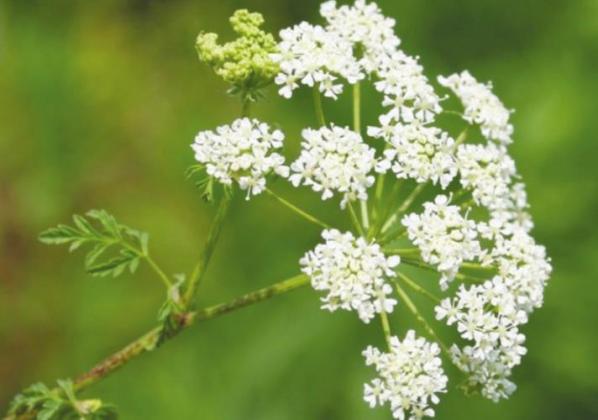STILLWATER, Okla. – Flowers are blooming and vegetables are ripe for picking out of the garden, but unfortunately, poison hemlock and other toxic plants are also blooming across the state.
Poison hemlock is one of the most toxic plants found in Oklahoma, excluding the Panhandle, said Laura Goodman, Oklahoma State University Extension range specialist.
“Poison hemlock is toxic to many different livestock species. In fact, some livestock and wildlife that consume this plant can die within 20 minutes,” Goodman said. “It doesn’t take very much to harm livestock and wildlife. Less than 500 grams can kill an animal. It’s also very toxic for humans. Simply touching the plant can make you sick.”
Poison hemlock features white, umbrella shaped flower clusters with fern-like leaves. Goodman said you can tell poison hemlock apart from other white flowering plants because of its height, which can be 6 to 10 feet tall. Another distinguishing feature is the red spotting on the stem.
If livestock have ingested poison hemlock, farmers and ranchers may notice neurological symptoms, said Dr. Barry Whitworth, OSU Extension veterinarian and food animal quality and health specialist.
“Livestock that have ingested this plant will likely demonstrate nervous system issues, such as tremors, being uncoordinated and walking funny,” Whitworth said. “They’re going to hypersalivate and could also have abdominal pain. The toxins will depress the nervous system, which means muscles aren’t going to function the way they’re supposed to, including the diaphragm. This can result in suffocation.”
Activated charcoal and vitamin K are treatments for poison hemlock toxicity. The charcoal absorbs the toxins and binds to the vitamin K to allow the animal to pass it.
“If we know an animal consumed poison hemlock, we can get it treated quickly. However, a farmer or rancher may not know the animal has ingested the toxic plant and will observe the symptoms later on.”
As far as eradicating poison hemlock from a field or in a landscape, avoid touching it. Goodman said treating it with herbicide can make it more palatable to livestock.
“This obviously isn’t a good treatment option if you’ve got livestock in the pasture, unless you can be sure to keep them away from it,” she said. “The stalks on the plant can remain toxic for up to three years; therefore, removing all above-ground growth is best after you’ve done any kind of herbicide treatment.” One option after doing an
One option after doing an herbicide spray is to do a controlled burn in the pasture. Goodman also suggests not using heavy stocking rates and rotational grazing systems that have high stock densities where livestock are forced to eat plants they don’t want to eat.
“These are just a couple of ways to keep your livestock from accidentally eating this plant,” she said.

